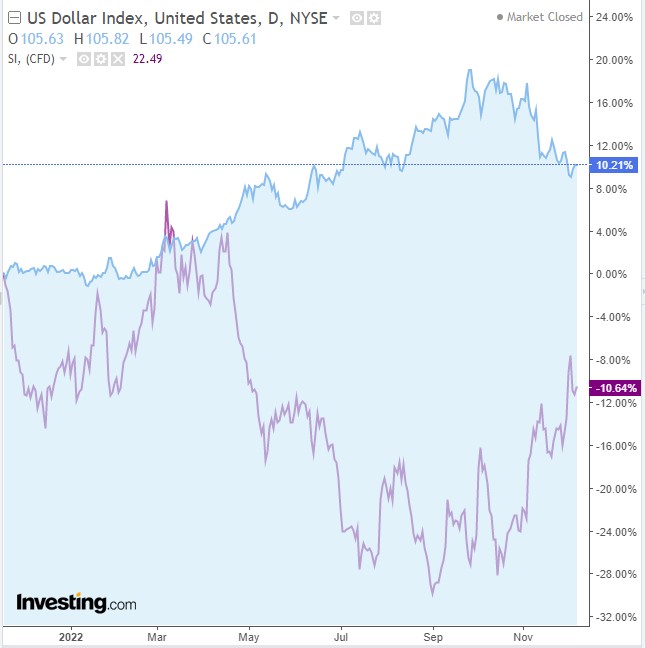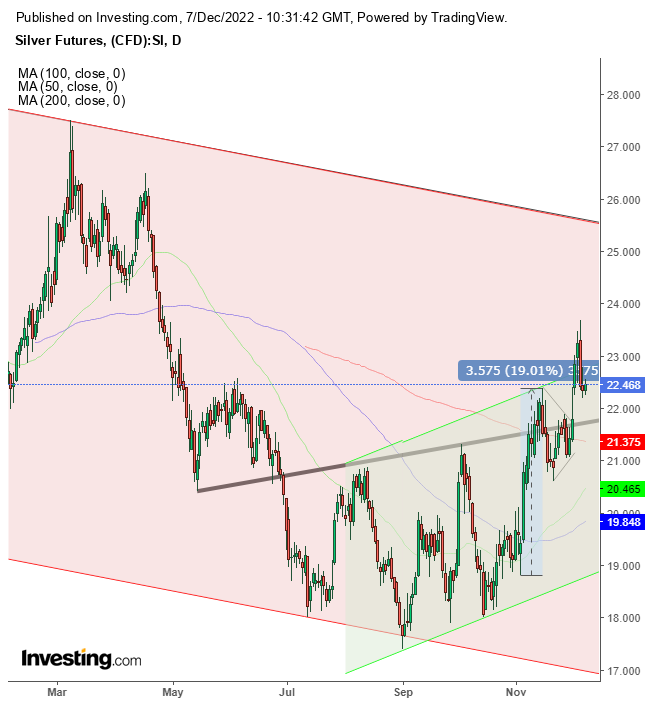Silver advanced four days in a row on expectations and follow-through of a softening Federal Reserve after Fed Chair Jerome Powell signaled his bank would slow the pace of tightening.

Silver and the dollar index possessed a negative correlation throughout most of the year when interest rates came into focus. The Fed has been shrinking its balance sheet and raising rates the most aggressively in four decades. That means that the dollar became more scarce, tilting more heavily on the side of demand, and at the same time, the Fed made banks pay more money for savers—adding another layer of demand.
The dollar added nearly 20% of the year's value until September 28. However, data indicating easing inflation spurred speculation inflation was peaking and that the Fed would be less hawkish, halving those gains till now.
The market has been going back and forth on this theme. On December 6, CNBC made the case that "Fed Chair Powell is having a communication problem with the market." CNBC Editor Jeff Cox argues that investors hear what they want to hear, but he says it in the context of dovish expectations. I have demonstrated—at least since November 30—that the positive or negative outlook correlates with the short-term trend, and I argued that it impacts investors psychologically.
Now, I'm going to make an even stronger argument. The short-term trend hasn't just been coloring traders' glasses. The Fed's too. In the most recent example, it wasn't investors' collective imagination. Still, the Fed Boss did utter:
"The time for moderating the pace of rate increases may come as soon as the December meeting."
Here is the Fed's transcript.

Now that the S&P 500's short-term is resynching with the medium-term downtrend, the outlook grows pessimistic on rates again.
Silver also has industrial applications and is heading for the biggest deficit in decades, according to the Silver Institute, impacting the supply-demand balance projected in the chart.

Silver completed a pennant, a range where bulls locked in up to 19% profits in just nine sessions. The white metal found resistance at the top of its rising channel, triggering a return move to retest the continuation pattern's integrity.
The pennant—where fresh bulls take over for tired bulls—developed on the very neckline of an H&S bottom, revealing the significance of these levels. Therefore, after a potential pullback, silver may be forced into a chain reaction to the roughly $25.00 top of a falling channel since the Feb 2021 peak, representing the medium-term (or long-term, depending on your definitions), agreeing with the H&S implied target.
Trading Strategies
Conservative traders should wait for silver to bounce off the H&S bottom neckline or pennant before risking a long position.
Moderate traders would wait for the buying dip.
Aggressive traders can enter according to their strategy. Here is a generic example:
Trade Sample
- Entry: $22.50
- Stop-Loss: $22.00
- Target: $24.00
- Risk: $0.50
- Reward: $1.50
- Risk-Reward Ratio: 1:3
Disclosure: At the time of publication, the author had no positions in the securities mentioned.
